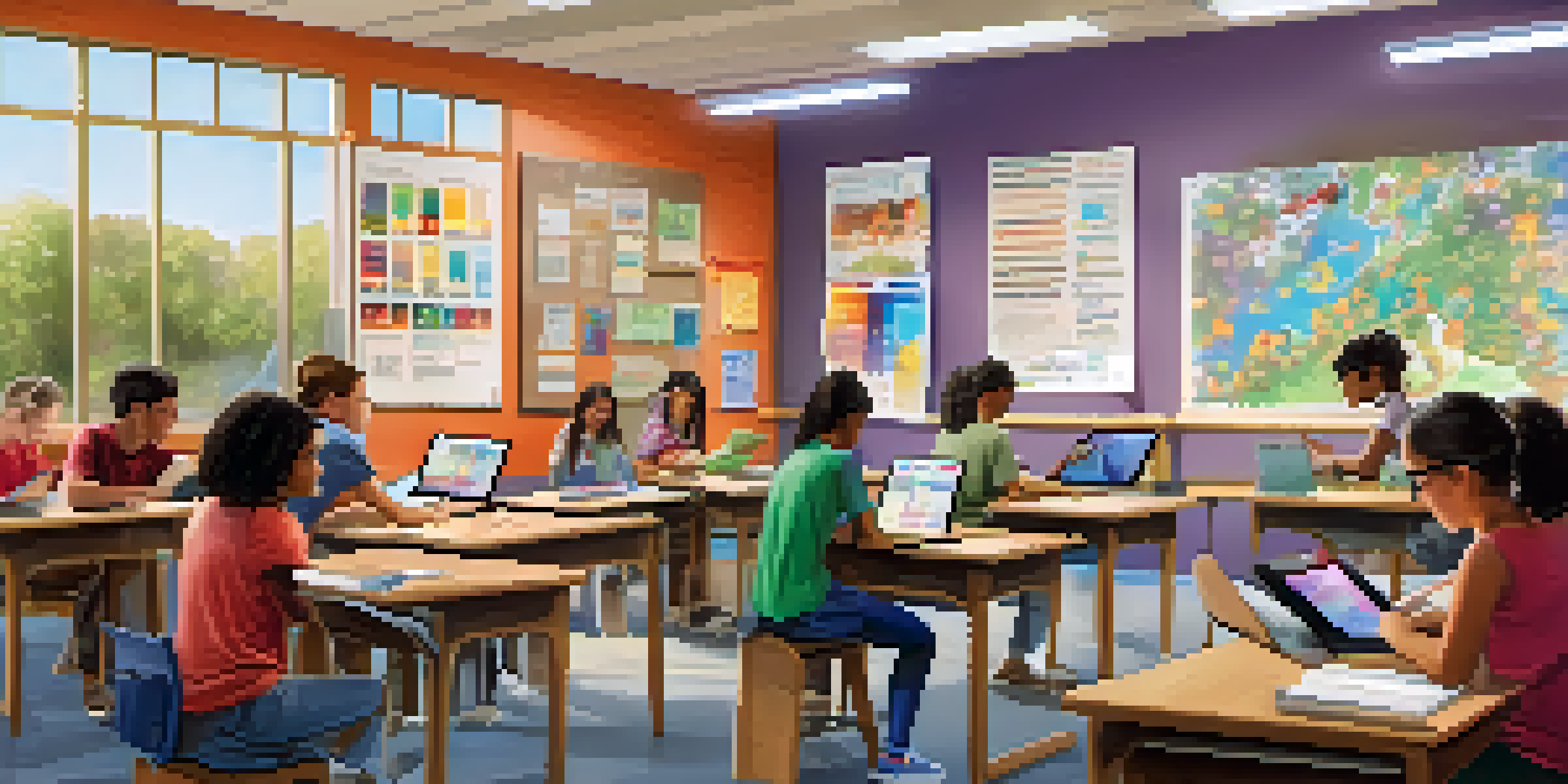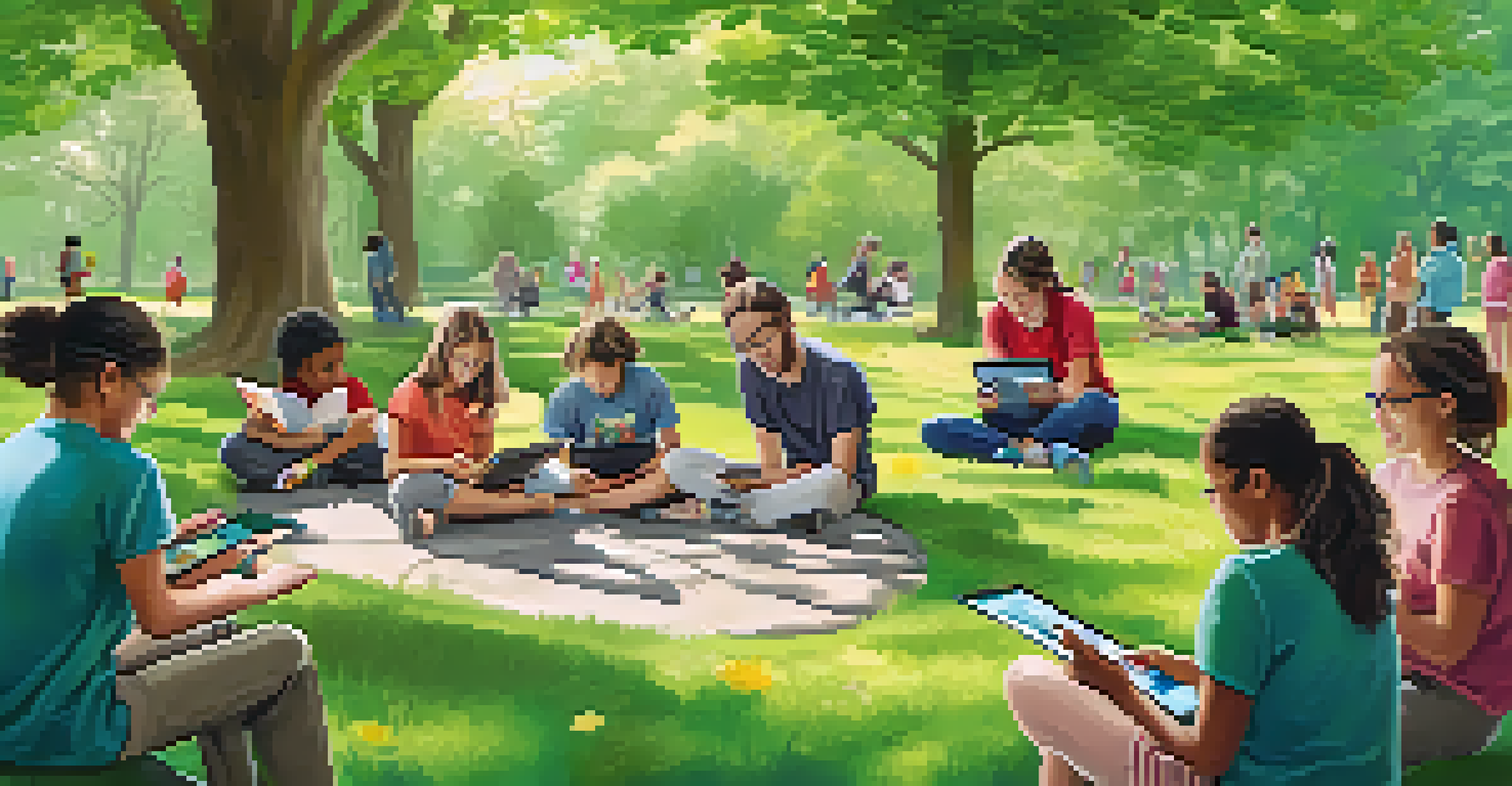Blended Learning and Special Needs Education: A Focused Study

Understanding Blended Learning in Education Settings
Blended learning combines traditional face-to-face teaching with online education, creating a hybrid model that can cater to diverse learning needs. This approach allows educators to leverage technology while maintaining personal interaction, making lessons more adaptable for students. For instance, students can review materials at their own pace online, which is especially beneficial for those who may require additional time to grasp concepts. By integrating various learning modalities, blended learning fosters a more inclusive environment.
Blended learning is not a new concept; its evolution allows educators to combine the best of both worlds: traditional teaching methods and modern technology.
In the context of special needs education, blended learning can be particularly transformative. It provides tailored resources and support that align with each student's unique learning profile. For example, a child with autism may thrive with visual aids available online, while another student with ADHD may benefit from the flexibility of choosing when to engage with lessons. This personalized approach helps ensure that all students have access to the tools they need to succeed.
Additionally, blended learning encourages collaboration among educators, specialists, and families. By utilizing shared online platforms, teachers can easily communicate with parents about progress and strategies, ensuring that everyone is on the same page. This collaborative spirit can lead to more effective interventions and a stronger support network for students with special needs.
Benefits of Blended Learning for Special Needs Students
One of the key benefits of blended learning is its ability to cater to different learning styles. Students with special needs often have specific preferences in how they absorb information; some excel with visual materials, while others prefer auditory resources. With blended learning, educators can mix these modalities seamlessly, providing a richer educational experience. This variety not only keeps students engaged but also enhances their understanding of the material.

Furthermore, blended learning offers increased accessibility, which is crucial for students with disabilities. Online components can be designed to be user-friendly, allowing for easy navigation regardless of physical or cognitive challenges. For instance, text-to-speech software can assist students with reading difficulties, while interactive simulations can engage kinesthetic learners. This accessibility empowers students to take charge of their own learning journey.
Another significant advantage of blended learning is the opportunity for self-paced learning. Many students with special needs benefit from being able to revisit lessons or complete assignments at their own speed. This flexibility can reduce anxiety and pressure, allowing them to focus on mastering the material rather than simply keeping up with their peers. Ultimately, this approach fosters a more positive learning environment.
Challenges in Implementing Blended Learning
While blended learning holds great promise, it's not without its challenges. One major issue is the digital divide; not all students have equal access to technology or reliable internet. This can create disparities in learning opportunities, particularly for students from low-income families. Educators must be mindful of these gaps and work to provide alternative resources for those who may struggle with online components.
The role of the teacher is to create the conditions for invention rather than provide ready-made answers.
Another challenge is the need for teacher training and support. Implementing blended learning effectively requires educators to be comfortable with technology and understand how to integrate it into their teaching. Professional development programs must be developed to equip teachers with the necessary skills and strategies for success. This investment in training is crucial for the program's overall effectiveness.
Additionally, maintaining engagement can be difficult in a blended learning environment. Students with special needs may require more support and motivation to stay focused, especially when working independently online. Teachers must find creative ways to encourage participation and interaction, such as incorporating gamified elements or regular check-ins, to keep students invested in their learning.
Strategies for Effective Blended Learning
To make blended learning effective for special needs students, educators should employ a variety of strategies. Firstly, setting clear, achievable goals helps students understand what is expected of them and provides a sense of direction. By breaking down larger tasks into smaller, manageable steps, teachers can help students build confidence and track their progress. For example, instead of assigning a lengthy project all at once, a teacher might divide it into phases with specific deadlines.
Secondly, incorporating assistive technologies can enhance the learning experience for students with disabilities. Tools like speech recognition software, audiobooks, and interactive apps can help bridge gaps in understanding and engagement. By ensuring that these resources are readily available, teachers can create a more inclusive learning environment that meets the diverse needs of their students.
Finally, fostering a supportive online community is essential. Creating forums or discussion groups where students can share experiences and ask questions can build a sense of belonging. This social interaction not only enriches the learning experience but also provides emotional support, which is particularly important for students with special needs.
Examples of Blended Learning in Action
Many schools have successfully implemented blended learning programs tailored to special needs students. For instance, a school district in California introduced a blended learning model that combines personalized online courses with one-on-one teacher support. This approach allowed students to progress through their lessons at their own pace while still receiving guidance from educators, significantly improving their academic performance.
Another example comes from a special education program in New York that utilizes a variety of multimedia resources. By integrating videos, interactive simulations, and virtual field trips into their curriculum, teachers engage students with different learning styles. This dynamic approach not only captures students' interest but also helps them connect real-world applications to their studies.
These examples illustrate the versatility and effectiveness of blended learning in special needs education. By adapting to the unique needs of students, schools can create an educational experience that fosters growth, independence, and achievement.
The Role of Parents in Blended Learning
Parents play a crucial role in the success of blended learning for their children with special needs. Their involvement can enhance the learning experience by providing additional support and encouragement at home. For example, parents can help their children navigate online platforms, set up a conducive learning environment, and monitor progress. This partnership between parents and educators is key to maximizing student outcomes.
Moreover, parents can offer valuable insights into their child's strengths and challenges, helping educators tailor their approach. By sharing information about their child's needs, preferences, and learning styles, parents can contribute to creating a more effective educational plan. This collaboration fosters a holistic approach to education, benefiting everyone involved.
Finally, engaging parents through regular communication is essential. Educators should keep parents informed about their child's progress and any challenges they may face in the blended learning environment. By maintaining an open dialogue, educators and parents can work together to address concerns and celebrate achievements, creating a supportive network that encourages student success.
Future Trends in Blended Learning for Special Needs Education
As technology continues to evolve, so too will the approaches to blended learning for special needs students. One promising trend is the increasing use of artificial intelligence (AI) to create personalized learning experiences. AI can analyze student performance data and adapt learning materials accordingly, providing tailored support that meets individual needs. This level of customization can be particularly beneficial for students with special needs.
Another exciting development is the rise of virtual and augmented reality (VR/AR) in education. These technologies can create immersive learning experiences that engage students in ways traditional methods cannot. For example, students with autism might benefit from virtual social skills training, allowing them to practice interactions in a safe and controlled environment. This hands-on approach can build confidence and improve real-world social skills.

Finally, the emphasis on social-emotional learning (SEL) will continue to shape blended learning practices. Recognizing the importance of emotional well-being, educators will strive to integrate SEL into their curriculum, helping students develop resilience and self-regulation skills. By focusing on the whole child, blended learning can provide a more comprehensive educational experience that prepares students for success both academically and personally.